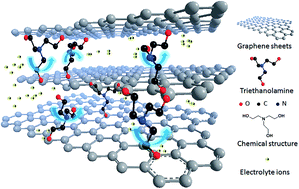Triethanolamine functionalized graphene-based composites for high performance supercapacitors†
Abstract
In this work, a graphene-based nanocomposite was prepared for use as a high-capacity supercapacitor electrode using triethanolamine (TEA) as an inter-layer spacer via a controlled hydrothermal process. The chemical functionalization of the molecular spacer onto the reduced graphene oxide (rGO) surface considerably increased the specific surface area and generated a 3D porous graphene network for efficient ionic diffusion and transport. In addition, the formation of oxygen-containing groups in the composite could effectively tune the surface chemistry, making the electrolyte ions more accessible to the electrode nanostructure. The unique compositional and structural features of the TEA/rGO were confirmed by several techniques, including TGA, FTIR, XPS, XRD and BET measurement. The as-fabricated electrode exhibited a superior capacitance of 211 F g−1 in a two-electrode configuration with excellent rate performance, low charge transfer resistance and outstanding cycling stability (91.7% of initial capacitance retained after 10 000 cycles). Furthermore, a maximum energy density of 25.7 W h kg−1 was achieved in organic electrolytes at a potential of 2.5 V. These impressive electrochemical characteristics of the TEA/rGO composite make it highly promising for high performance energy storage applications.


 Please wait while we load your content...
Please wait while we load your content...